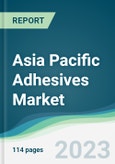Asia Pacific adhesives market was valued at US$27.463 billion in 2021 and is projected to expand at a CAGR of 5.82% over the forecast period to reach US$40.802 billion by 2028.
The primary factors driving market expansion in the Asia Pacific region include growing industrialization, strong GDP growth, and a rise in manufacturing and industrial production. India, China, and Japan are expected to contribute significantly to the growth of this industry. Additionally, China is the world's largest manufacturer of electronics.Higher Production of Electronic Goods
A significant portion of the market is dominated by electronic goods including smartphones, tablets, OLED TVs, etc. Further, the Japanese construction sector is anticipated to experience tremendous expansion over the coming several years which will fuel the adhesives market. For instance, as per the data published by the Ministry of Land, Infrastructure, Transport, and Tourism, in Japan, there were 13, 291 thousand square meters of construction land for warehouses in 2022, whereas that for factories and offices were 8, 747 and 5, 705 thousand square meters respectively.Numerous Undertaken Measures by the Companies
Various companies in the Asia Pacific region are focusing on acquisition and product innovations leading to market expansion. For instance, Henkel purchased Sonderhoff Group, a manufacturer of adhesives with facilities in China, in June 2022. As a result, the company has grown its technological portfolio in the area and improved its Adhesive Technologies division. In January 2021, Huntsman Corporation completed the acquisition of Gabriel Performance Products (Gabriel) from Audax Private Equity. Additionally, in February 2022, Arkema acquired the Chinese firm PMP (Shanghai Zhiguan Polymer Materials), which specializes in reactive hot-melt polyurethane (HMPUR) adhesives and has annual sales of more than €1 million.Growing Application in Medical Devices
The main factors influencing the growth of medical adhesives are the increased acceptance of minimally invasive procedures and the rising number of medical implant transplant operations in the Asia Pacific region. Medical adhesives promote the healing of natural wounds and stop air and liquid leaks before and after surgical operations, among other uses. Medical adhesives are used as a tool to help stop blood loss during various surgical operations such as orthopedic surgery, organ implants, and cardiovascular surgery. According to National Organ & Tissue Transplant Organization, the number of organ transplants in India was 7, 443 in 2020 and it increased to 16, 041 in 2022.India is Expected to Grow Significantly
The favorable investment inflows and government initiatives to boost industrial productivity have resulted in bolstering the growth of these major adhesive end-users in India. For instance, the International Organization of Motor Vehicle Manufacturers data (OICA), states that in 2022, India witnessed a 24.15% increase in its automotive production with the volume reaching up to 5.45 million units. Furthermore, the ongoing establishment of adhesive manufacturing facilities coupled with new product launches in the Indian market are acting as an additional driving factor. For instance, in March 2023, Pidilite Industries Limited announced to manufacture of its German counterpart Jowat Adhesive’s hot-melt adhesives in its Gujarat facility under the brand name “Fevicol Jowat”.Major Market Player
- NANPAO RESINS CHEMICAL GROUPis a leading manufacturer of specialty adhesives, footwear adhesives, liquid and powder coatings, hot-melt adhesives, and construction materials in Taiwan. With over 2800 employees worldwide, the company has factories and subsidiaries in various countries.
Key Market Developments
- In June 2023, Henkel began construction on a new production site for its Adhesive Technologies business unit in Shandong Province, China's Yantai Chemical Industry Park. The new facility, known as Kunpeng in Chinese, will increase Henkel's capacity to produce high-impact adhesive products in China with an investment of roughly 120 million euros (RMB 870 million).
- In February 2023, the new medical adhesive from 3M was launched. This medical adhesive can adhere to the skin for up to 28 days and is designed to work with a variety of sensors, long-term medical wearables, and health monitors. To support the delivery of a more patient-centric form of care, 3M now doubles that standard.
- In February 2022, the first sheet-type absorbable adhesion barrier created in Japan, TENALEAFTM, has been approved as a medical device by Osaka-Gunze Limited. The business introduced the product to the Japanese market through its subsidiary "Gunze Medical Japan" in March 2022.
- In October 2022, a new technical center in the Yonghe neighborhood of Guangzhou, China, was formally inaugurated by H.B. Fuller.
Segmentation
By Technology
- Water-based
- Solvent-based
- Hot-Melt
- Reactive and Others
By Products
- Acrylic
- Epoxy
- Ethyl Vinyl Acetate
- Polyurethane
- Polyvinyl Acetate
- Others
By Application
- Packaging
- Construction
- Consumer Appliances
- Leather
- Laminates
- Automobile
- Others
By Country
- Japan
- China
- India
- South Korea
- Indonesia
- Thailand
- Others
Table of Contents
Companies Mentioned
- 3M
- H.B. Fuller Company.
- Henkel AG & Co. KGaA.
- Hubei Huitian New Materials Co. Ltd.
- Nanpao Resins Chemical Group.
- Arkema Group
- Beijing Comens New Materials Co., Ltd.
- Avery Dennison Corporation
- Burim Chemical Co., Ltd
Methodology

LOADING...
Table Information
| Report Attribute | Details |
|---|---|
| No. of Pages | 114 |
| Published | October 2023 |
| Forecast Period | 2021 - 2028 |
| Estimated Market Value ( USD | $ 27.46 Billion |
| Forecasted Market Value ( USD | $ 40.8 Billion |
| Compound Annual Growth Rate | 5.8% |
| Regions Covered | Asia Pacific |
| No. of Companies Mentioned | 9 |









